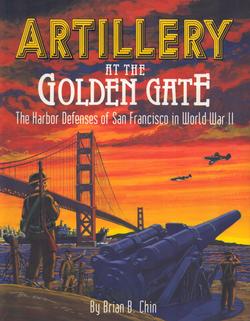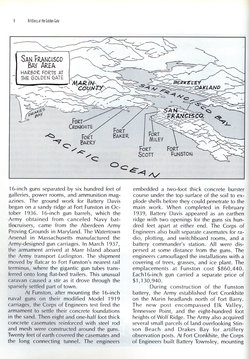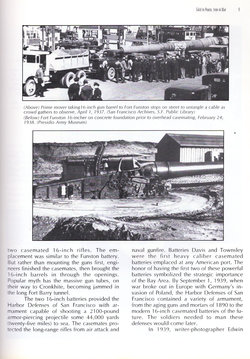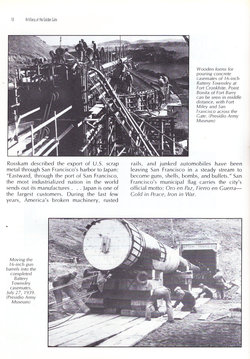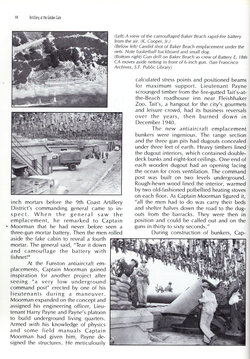ARTILLERY
AT THE GOLDEN GATE BRIDGE WW2 SAN FRANCISCO FORTS HARBOR DEFENSES HDSF FORT
CRONKHITE FORT BARRY FORT BAKER FORT WINFIELD SCOTT FORT MILEY FORT FUNSTON
BATTERY DAVIS BATTERY TOWNSLEY U.S. ARMY COASTAL ARTILLERY CAMP SPUR 16-INCH
GUNS 155mm HOSPITALITY HOUSE at CIVIC CENTER BAKER BEACH 90mm ANTI-AIRCRAFT
ARTILLERY AA EMBARCADERO DRAKES BAY USAMP NILES HSDF MINE BATTALION FLOTILLA
PRESIDIO MARIN SEARCHLIGHT BATTERY U.S. ARMY TRANSPORTATION CORPS WOMEN�S ARMY
CORPS QUARTERMASTER BATTALIONS HUNTERS POINT AIR RAID SIREN INSTALLATIONS USAMP
HORACE F. SPURGIN SAUSALITO DOCK USAMP SAMUEL M. MILLS COLD WAR 120mm AA GUNS
CONCRETE SOLDIERS MINEFIELDS
SOFTBOUND BOOK in ENGLISH by
BRIAN B. CHIN (1994)
Illustrated with 170 historical
photographs and four maps detailing the events before, during, and after World
War II in the San Francisco Bay Area
Fort Funston is a former harbor
defense installation located in the southwestern corner of San Francisco.
Formerly known as the Lake Merced Military Reservation, the fort is now a
protected area within the Golden Gate National Recreation Area (GGNRA) and is
used widely as an off-leash dog park. It was named in honor of Frederick N.
Funston (1865�1917), a Major General in the United States Army with strong
connections to San Francisco, and included several artillery batteries. The
fort is located on Skyline Boulevard at John Muir Drive, west of Lake Merced.
The fort was constructed upon
windswept headlands along the Pacific coast and Ocean Beach below, above steep
sandstone cliffs that provide a nesting habitat for a colony of bank swallows
(Riparia riparia). The last remnants of a sand dune ecosystem that once covered
the western half of San Francisco grows along the top of the headlands, with
trailheads forming part of the California Coastal Trail that runs through San
Francisco County
Following World War I, the
Washington Naval Treaty of 1923 caused the cancellation of numerous battleships
and battlecruisers building and planned for the US Navy. Some of the guns
intended for these ships were made available to the United States Army Coast
Artillery Corps to defend key ports against a potential naval attack. However,
only a few of these weapons were emplaced prior to the outbreak of World War II
in September 1939. In 1936�1939 Battery Davis was built at Fort Funston,
housing two 16-inch Mark 2 Navy guns. These 143-ton guns were moved on railroad
cars in 1937 from Mare Island Naval Shipyard to Southern Pacific's Ocean View
Station. This was the prototype US 16-inch battery for casemating against air
attack, which was adopted for almost all US 16-inch batteries built during the
war and retrofitted to most pre-war batteries of this type. It was also the
prototype for the Army's M2 carriage; previous ex-Navy 16-inch guns had used a
modified M1919 carriage designed for the 16-inch gun M1919. Battery Davis was
named for Major General Richmond P. Davis, a Coast Artillery officer who served
in France in World War I, retired in 1929 and died in 1937. Also, an unnamed
battery of four 155 mm guns on concrete "Panama mounts" was built at
the fort circa 1938.
In 1940 Battery Davis was joined
by Battery Townsley at Fort Cronkhite. A third 16-inch battery, Battery 129
(also called "Construction 129") at Fort Barry, was built for the San
Francisco area during World War II but not completed or armed. Four additional
155 mm guns on Panama mounts were emplaced as Battery Bluff. Also, four 40 mm
Bofors gun batteries were placed around the fort.
From December 1941 through April
1944 Fort Funston's garrison included elements of the 18th Coast Artillery
Regiment.
The gun batteries were declared
obsolete shortly after World War II, but a 90 mm anti-aircraft gun battery was
on the site 1953-57 during the Cold War. Fort Funston later became a Nike
missile launch site, hosting sites SF-59L (now the parking lot) and SF-61 from
1956 to 1963. The fort was inactivated in 1963 and eventually transferred to
the National Park Service to be administered as part of the Golden Gate
National Recreation Area. At some point Batteries Howe and Bruff were
demolished, while the Panama mounts have either been destroyed by erosion or
buried.
By 1937, the army had decided
that 12-inch batteries such as Chester should be abandoned when the harbor
defenses could again be modernized with a new generation of defenses. However,
the Japanese attack on Pearl Harbor brought the United States into the Second
World War before the new modernization project was completed and Battery
Chester's guns continued to play an important role in coastal defense until
1943. The Allied victories in the Pacific War that year reduced the danger of
an enemy attack on San Francisco to such an extent that the army ordered
Battery Chester's guns be salvaged.
Battery 243 (Construction
Number) at Fort Miley was completed in 1944, designed for two 6-inch rapid-fire
guns protected by steel shields rather than the traditional concrete-and-earth
parapets. This type of coastal gun was considered to be of value at that late
date in the war because of its function to cover the submarine minefields
outside the Golden Gate, making minesweeping by the enemy difficult if not
impossible. Its guns were not mounted until 1948, after most other types of
coastal guns had been scrapped. This battery is historically significant
because it represents one of the last phases of the traditional concept of
coastal defense.
The fort's garrison included
Battery F, 18th Coast Artillery from November 1941 through April 1944.
By December 1942, during World
War II, there were 159 structures at Fort Baker, many of them temporary. For
example, a temporary frame hospital, built near the beach at the foot of the
parade ground, was completed in October 1941 and demolished in 1981.
During WWI and WWII Fort Baker
became the headquarters and training command post for the newly formed 91st
Division (United States) Army. During WWI the division served in France. In
WWII the division served in Italy. Since the soldiers in this division came
from the far western states it became known as The Wild West Division. Since
the Powder River in Wyoming was a well known river during the army's campaigns
against the native American peoples, this river was also known by this era's
soldiers. Out of this they developed the custom when an enlisted saluted an
officer he would say, "Powder River!" when the officer returned the
salute he would say, "Let'er buck!" This became a tradition in the
91st Division which was practiced into the third millennia.
Fort Barry is a former United
States Army installation on the West Coast of the United States, located in the
Marin Headlands of Marin County, California, north of San Francisco. Opened 116
years ago in 1908, the fort was part of the Coast Artillery Corps and operated
throughout the 20th century, before its closure and eventual transfer to the
National Park Service.
The fort was initially armed
with 5 batteries:
Battery Mendell was the first
battery to be built at the fort, beginning in July 1901. It had two 12-inch
breech-loading rifles, Model 1895, on Buffington-Crozier
"disappearing" carriages Model 1897. It was named for Colonel George
Mendell, the engineer officer who had supervised construction of batteries
around San Francisco Bay.
Battery Alexander was an
eight-mortar battery with Model 1890 breech-loading 12-inch mortars mounted on
model 1896 Mark I carriages. It was named for Colonel Barton S. Alexander.
Battery Edwin Guthrie mounted
four six-inch rapid-fire guns, Model 1900, mounted on barbette carriages. The
battery was named for Captain Edwin Guthrie, of the 15th Infantry Regiment.
Battery Samuel Rathbone also
mounted four six-inch rapid-fire guns, Model 1900, mounted on barbette
carriages. The battery was named for Lieutenant Samuel Rathbone.
Battery Patrick O'Rorke mounted
four 15-pounder, 3 inch guns on Model 1903 pedestal mounts. The battery was
named for Colonel Patrick O'Rorke.
Battery Elmer J. Wallace, was
added in 1917 with two long-range 12-inch guns each with a 360-degree field of
fire.
Battery Construction No. 129 was
built on the summit of the fort in 1943 to contain two 16-inch guns, but was
never armed or named.
Later, the area above Battery
129 became the radar and control area for Nike Missile Site SF-87 whose launch
area was in Fort Cronkhite.
Fort Cronkhite is one of the
components of California's Golden Gate National Recreation Area. Today part of
the National Park Service, Fort Cronkhite is a former US Army post that served
as part of the coastal artillery defenses of the San Francisco Bay Area during
World War II. The soldiers at Cronkhite manned gun batteries, radar sites, and
other fortifications on the high ridges overlooking the fort.
History
Named for former U.S. Army Major
General Adelbert Cronkhite, Fort Cronkhite was established in the late 1930s.
With the rapid military buildup of the United States in the early 1940s, tens
of thousands of temporary wooden structures had to be built by the army to
house its growing ranks. The army's Quartermaster Corps and the Corps of
Engineers were put in charge of the building projects around the country. Using
standard plans, all types of buildings could be built in short time including
barracks, mess halls, supply depots, chapels, and recreation buildings. Many of
these types of "temporary" wooden building can still be found at Fort
Cronkhite today over 70 years later. The first unit to move into the fort was
Battery E of the 6th Coast Artillery in June 1941. The soldiers stationed at
the fort manned local artillery emplacements as well as the three gun, 3 inch
Antiaircraft Battery No. 1.
Battery Townsley
Named for Major General Clarence
P. Townsley, who had commanded the 30th Infantry Division in France in World
War I, construction of Battery Townsley began in 1938 with the excavation for
the large magazine and gun emplacement on the ridge overlooking what would
become Fort Cronkhite. When it was completed in 1940 and transferred to the
Coast Artillery Corps it was the second 16-inch battery on the West Coast,
after Battery Davis at Fort Funston. The battery was manned at all times with
the men on each shift living in the concrete walls of the battery high on the
ridge. Battery Townsley is open to the public every first Sunday of the month,
from 12 noon to 4 PM.
Post War
During the Cold War Fort
Cronkhite was used to house soldiers of the nearby SF-88 Nike Missile launch
site. SF-88 operated throughout the 1960s and early 1970s until it was
permanently closed in 1974. Many of the older wooden buildings of the fort had
already started to be torn down by the army in the previous years and with the
closure of SF-88 Fort Cronkhite was closed altogether soon after.
Decommissioning
Fort Cronkhite was discontinued
as a United States Army installation effective 10 September 1974 by General
order Number 25.



